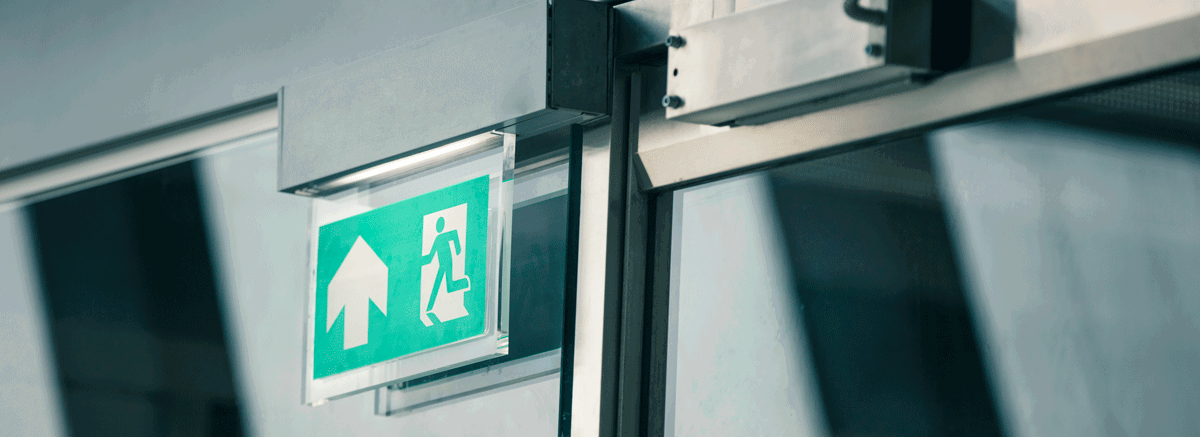
In the event of a fire, good building design and maintenance are essential to aid the safe evacuation of occupants, minimise the spread and provide acceptable safety conditions for rescue teams. Time is critical: The best fire protection solutions consider the specific design of individual buildings and how they are used by occupiers, combining both active and passive measures in a holistic approach.
The challenge is to control a fire after it has reached its fully-developed stage – a point known as the ‘flashover’. The aim in any building must be to contain the fire for as long as possible to allow people to escape and rescue teams to operate safely.
This can be achieved by combining a series of actions that we call passive protection and active protection.
Active protection, such as fire alarms, sprinklers, fire extinguishers, standpipe systems and smoke extraction can help to contain fire and to protect property and life. These systems require automation in order to work efficiently, so that when fire and smoke are detected in a facility, a fire or smoke alarm will alert those who are inside the building. Sprinkler systems and fire extinguishers can help to slow the growth of the fire until firefighters have a chance to intervene. Systems for smoke extraction, like roof hatches or mechanical smoke extraction by fans and smoke ducts, can extend time to, or totally prevent, flashover. They also assure an acceptable level of smoke for evacuation.
Passive fire protection is a group of systems that compartmentalise a building through fire-rated walls and floors and structural protection, preventing the fire from spreading quickly and protecting a building structure for as long as possible to provide time for building occupants to escape.
Ultimately, active systems cannot work without passive fire safety materials, and the two approaches need to work in tandem – a sprinkler system cannot suppress a building fire if the ceiling it is attached to has collapsed.
The principles of passive fire protection
Compartmentation requires walls, ceilings and structural elements to have proven fire resistance characteristics. It’s vital that these compartment elements deliver the required performance in real situations, not just in simpler fire test configurations. For instance, the corners, the connections with other walls or ceilings, the suspension and hanging elements, the fixing methods and the joints are all critical points and should be analysed and tested under real world conditions.
All holes, joints and passages of pipes or cables should be adequately protected because these penetrations can become a route for fire and smoke spread and consequently undermine the compartmentation principle.
Gaps and openings in large areas, such as floors with common service shafts, should be fully and properly sealed using the appropriate products and systems employed for sealing such gaps and openings. Such gaps also include any joints or open spaces due to poor workmanship or those left for designed structural movement.
One of the most important design considerations is also to include multiple escape routes and, in the case of tall buildings, at least two staircases placed far apart. The staircases must be pressurized, designed to be fireproof compartments that keep smoke out. The staircases and, in general, the escape route should always be kept clear of combustible materials and fabricated, as much as possible, with non-combustible materials.
Some national regulations allow the construction of tall residential buildings even with one staircase, provided that they are appropriately designed, while others allow a performance-based approach (so-called fire safety engineering), requiring designers to themselves evaluate the number of stairways and the evacuation times.
Key passive protection measures are safety zones or super-efficient compartments – which are uninhabited floors or rooms designed to resist the spread of fire for much longer than normal.
From an evacuation perspective, refuge floors present several advantages: They are a place of rest for the evacuees; the possibility of having stairs or lift shafts filled with smoke is reduced; they can be employed to protect people with disabilities or injured evacuees; they can be used as a command point for rescue teams to assist evacuation; and they can serve as a fire-fighting base.
Any passive protection system is, of course, only as good as the installation process. In each country, relevant local fire building codes and legislation apply.
Finding the right balance
High-quality construction, the effective combination of passive and active protection, escape route design, installation and ongoing risk management are all crucial. They all contribute to the safety of occupants and rescue teams, as well as to the protection of the building assets during a fire.
Allied to this is the specification of appropriate materials and systems, which must be tested in real conditions, along with competent installation, inspection and maintenance to provide peace of mind for building occupants and asset owners.

